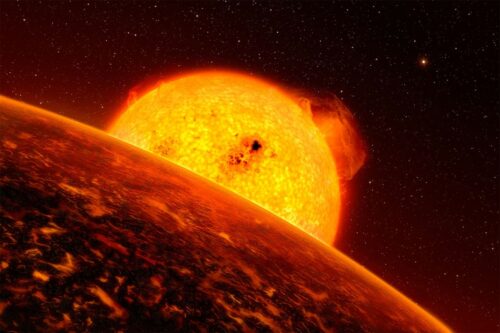Courtesy of NASA Goddard Space Flight Center.
Astronomers and laymen alike have wondered whether earth-like planets––ones with the capacity to host life on their surfaces––exist in the vast expanse of our galaxy.
A collaboration led by scientists at Yale has made progress on this problem. Rachael Roettenbacher and Sam Cabot of Debra Fischer’s lab use radial velocity observations, measures of a star’s motion toward and away from Earth, to find shifts in the color of its light. These shifts indicate that the star’s center of mass has moved from the gravitational tug of exoplanets, planets orbiting around the star. However, spots on a star, areas that appear cooler than others because the star’s magnetic field has stifled heat energy transport, can distort light to mimic or degrade the signs of an exoplanet. Roettenbacher and Cabot focus on dark spots and how they affect radial velocity measurements.
“Now, these starspots are still very hot, but since they’re contrasted with a hotter environment, they appear dark,” Roettenbacher said. Roettenbacher has been studying spotted stars since she was an undergraduate. “[I have] always been interested in [understanding] how we can detect the smaller spots in these sun-like stars,” Roettenbacher said. Cabot has been studying exoplanets and radial velocity techniques since he was a first-year graduate student at Yale and has made these subjects a core part of his Ph.D. thesis.
A regular challenge in identifying exoplanets has been that dark and bright spots on a star’s surface warp measurements of radial velocity. However, Roettenbacher and Cabot can now use the advanced technology of Fischer’s EXtreme PREcision Spectrograph (EXPRES) and other major astronomical facilities. These facilities include the Transiting Exoplanet Survey Satellite (TESS) and the Center for High Angular Resolution Astronomy (CHARA) Array, an interferometric array.
The researchers specifically studied the star Epsilon Eridani, a crowd favorite in astronomy communities since it is one of the brightest stars in the night sky. Epsilon Eridani is also especially active. “Spots appear and disappear frequently on its surface, making it difficult to find new planets around it. But that also makes it an exciting star for testing new methods,” Cabot said.
Using TESS, the team made reconstructions of the surface of Epsilon Eridani from which they modeled radial velocities, then compared their model to the data from the EXPRES. “[We] plotted it and got [the] model, and it looked exactly like [the] data, which was really exciting. There is still room for improvement, but it means the model we have now is pretty accurate,” Cabot said.
The team has its sights set on the next steps for this powerful technology. They continue to study Epsilon Eridani—this time using the CHARA Array to obtain an image of the stellar surface to improve the model radial velocities and perfect their method for the search of exoplanets.

